Abstract
OBJECTIVES. This study sought to examine the association between the psychosocial work environment and subsequent rates of sickness absence. METHODS. The analyses were based on a cohort of male and female British civil servants (n=9072). Rates of short spells (<or=7 days) and long spells (>7 days) of sickness absence were calculated for different aspects of the psychosocial work environment, as measured by self-reports and personnel managers' ratings (external assessments). RESULTS. Low levels of work demands, control, and support were associated with higher rates of short and long spells of absence in men and, to a lesser extent, in women. The differences were similar for the self-reports and external assessments. After adjustment for grade of employment, the differences were diminished but generally remained significant for short spells. The combination of high demands and low control was only associated with higher rates of short spells in the lower grades. CONCLUSIONS. The psychosocial work environment predicts rates of sickness absence. Increased levels of control and support at work could have beneficial effects in terms of both improving the health and well-being of employees and increasing productivity.
Full text
PDF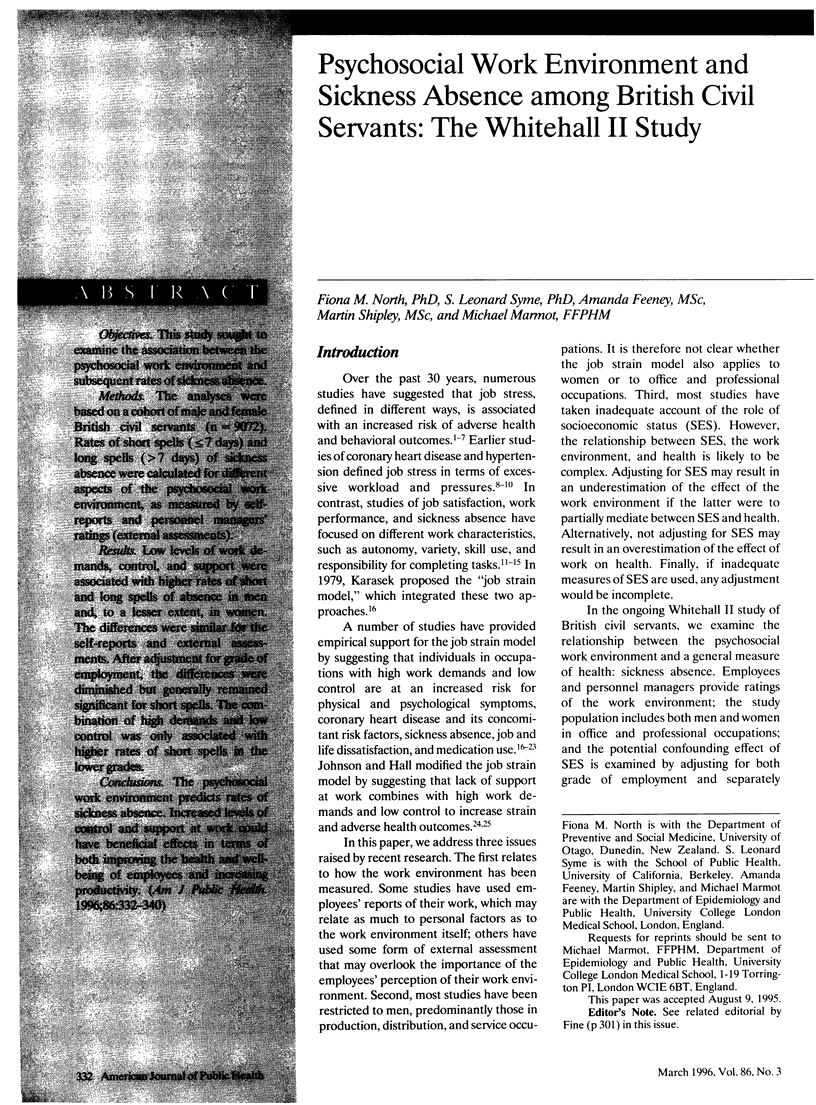
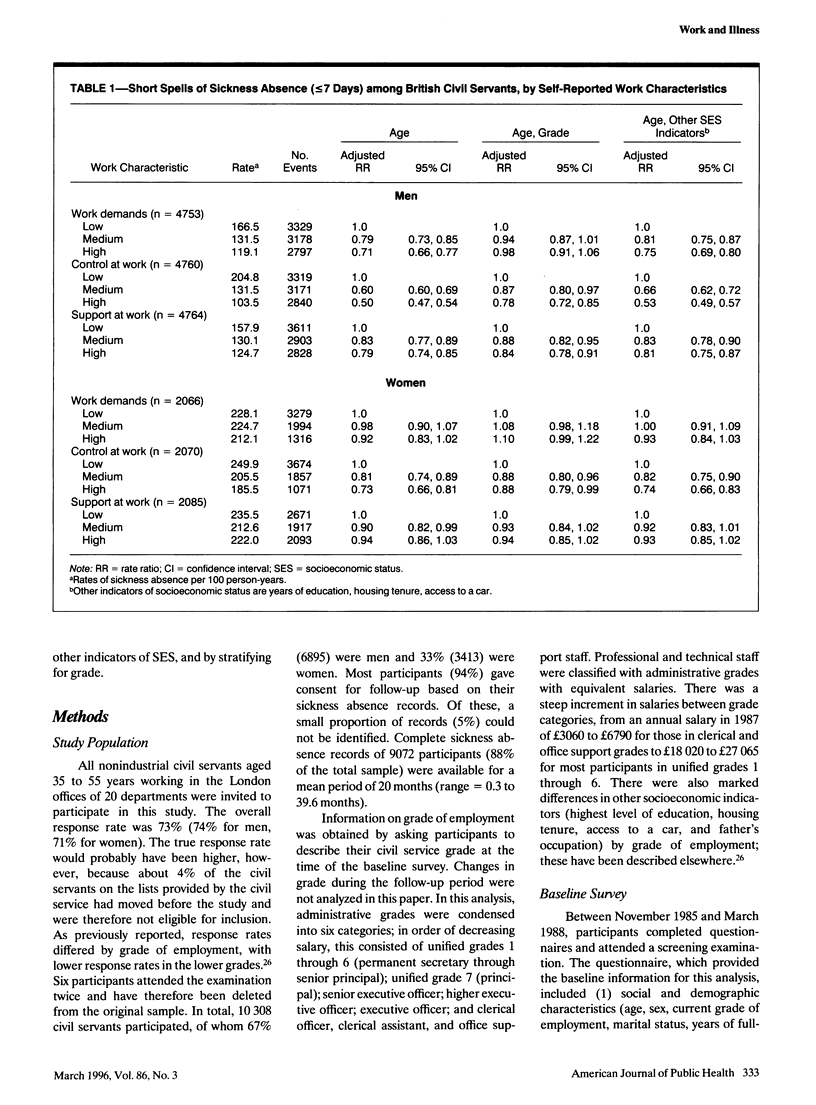
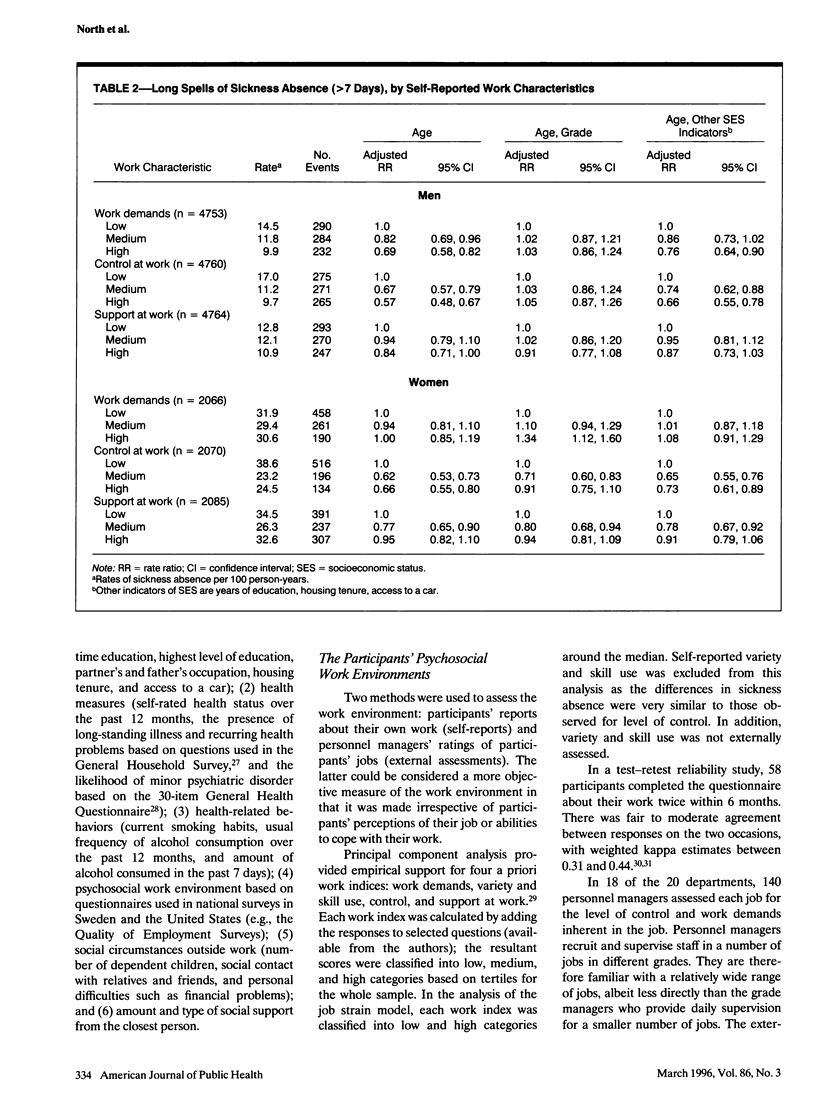
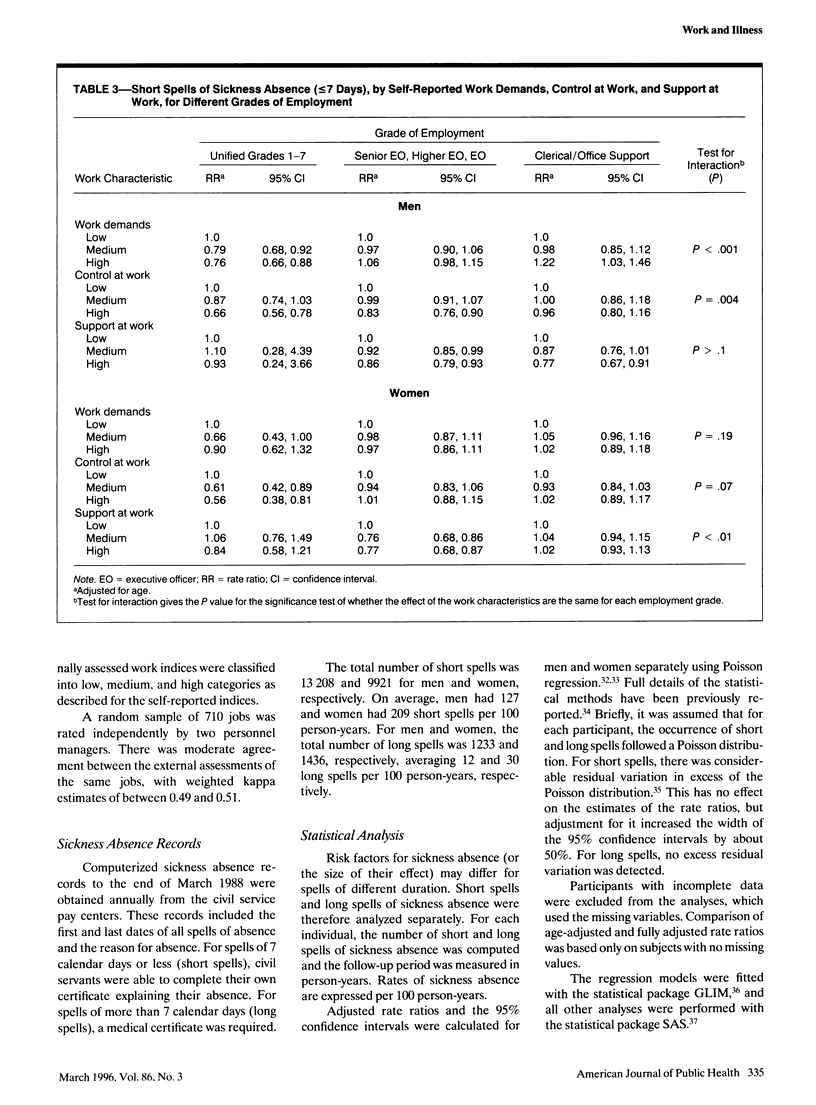
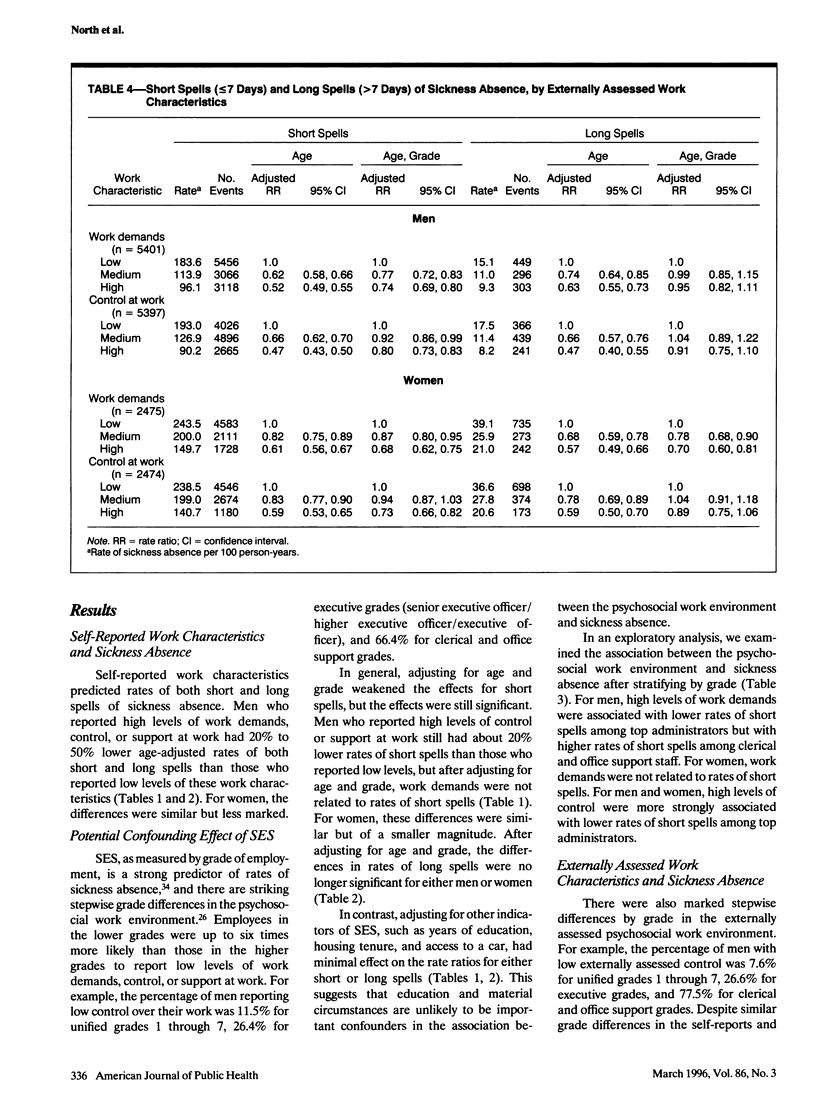
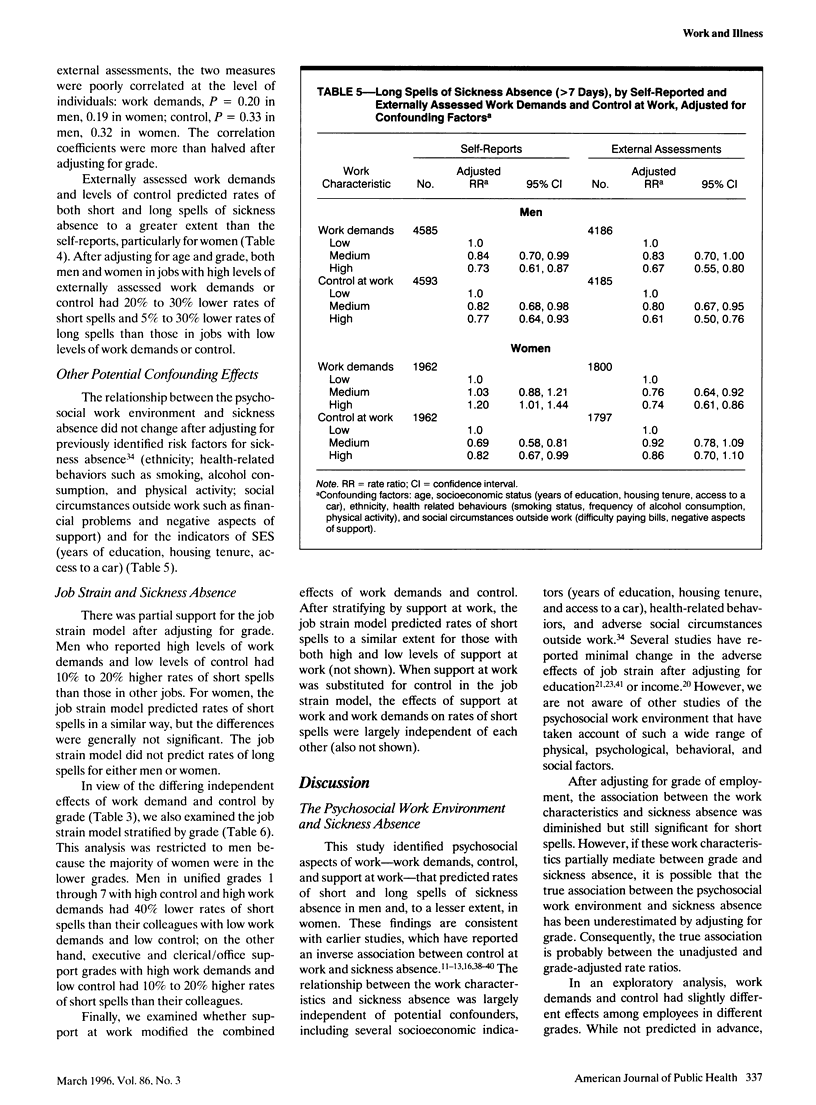
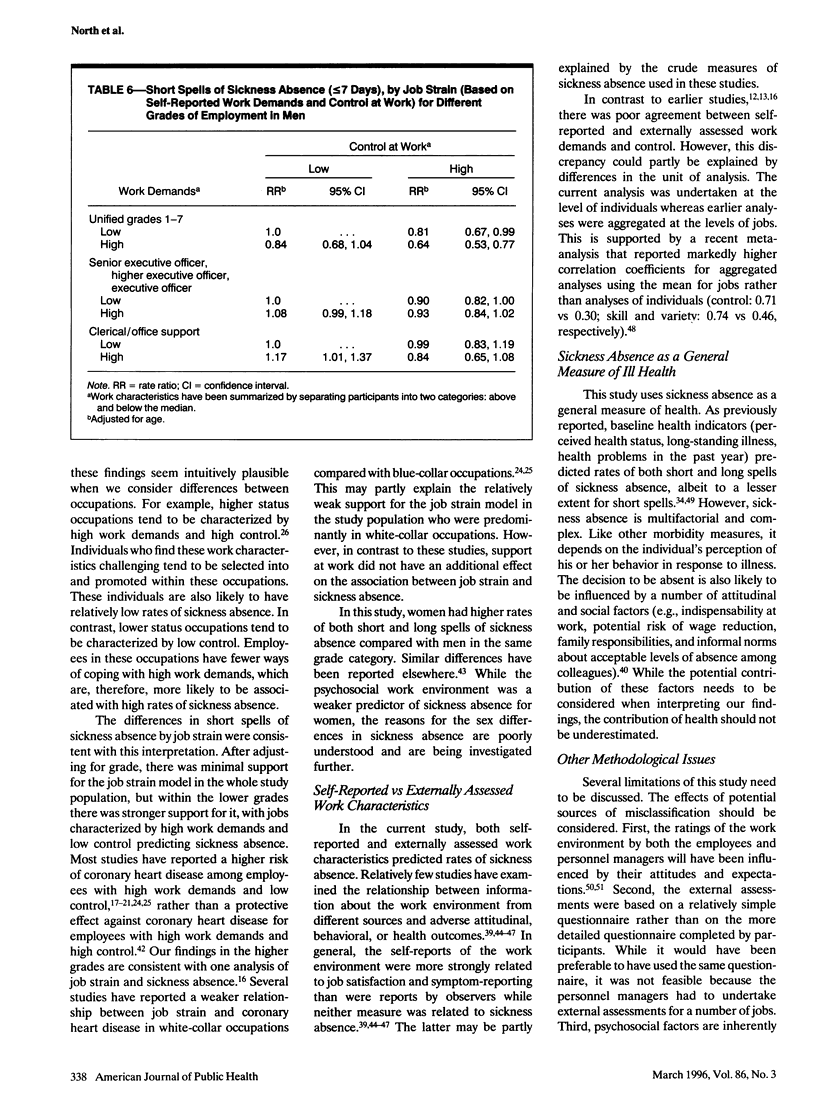

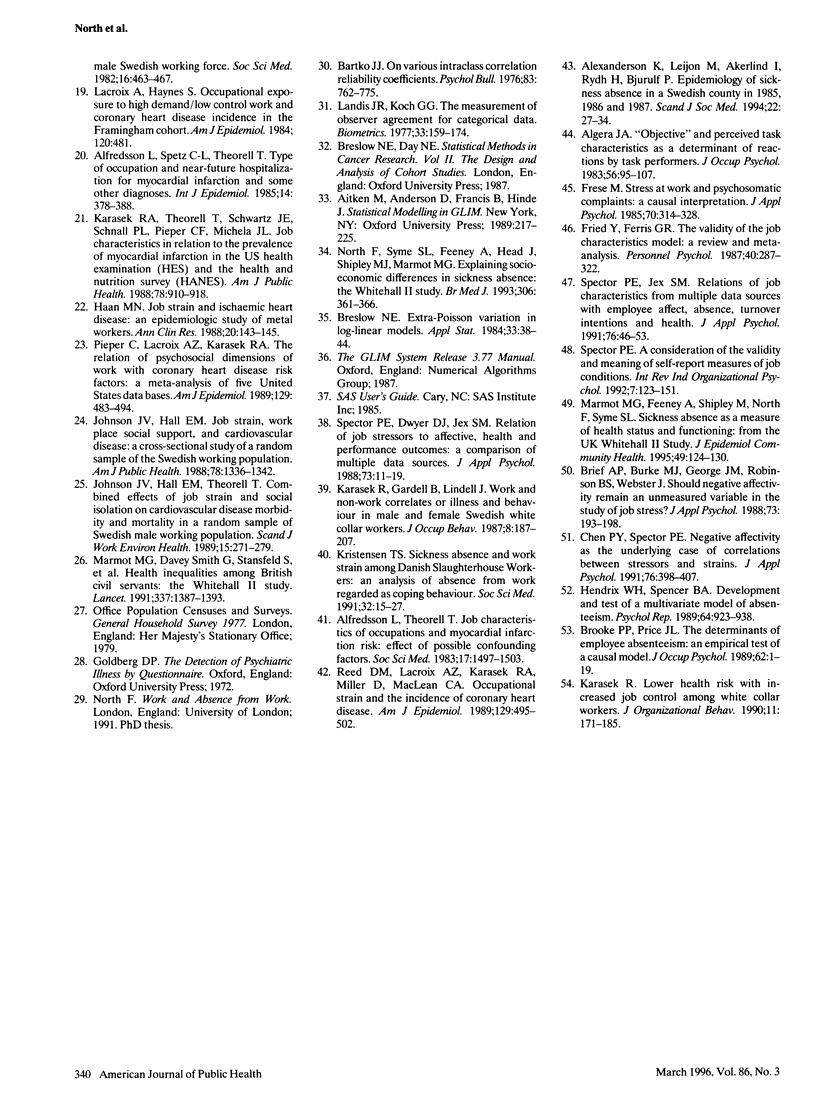
Selected References
These references are in PubMed. This may not be the complete list of references from this article.
- Alexanderson K., Leijon M., Akerlind I., Rydh H., Bjurulf P. Epidemiology of sickness absence in a Swedish county in 1985, 1986 and 1987. A three year longitudinal study with focus on gender, age and occupation. Scand J Soc Med. 1994 Mar;22(1):27–34. doi: 10.1177/140349489402200105. [DOI] [PubMed] [Google Scholar]
- Alfredsson L., Spetz C. L., Theorell T. Type of occupation and near-future hospitalization for myocardial infarction and some other diagnoses. Int J Epidemiol. 1985 Sep;14(3):378–388. doi: 10.1093/ije/14.3.378. [DOI] [PubMed] [Google Scholar]
- Alfredsson L., Theorell T. Job characteristics of occupations and myocardial infarction risk:effect of possible confounding factors. Soc Sci Med. 1983;17(20):1497–1503. doi: 10.1016/0277-9536(83)90094-1. [DOI] [PubMed] [Google Scholar]
- Baker D. B. The study of stress at work. Annu Rev Public Health. 1985;6:367–381. doi: 10.1146/annurev.pu.06.050185.002055. [DOI] [PubMed] [Google Scholar]
- Brief A. P., Burke M. J., George J. M., Robinson B. S., Webster J. Should negative affectivity remain an unmeasured variable in the study of job stress? J Appl Psychol. 1988 May;73(2):193–198. doi: 10.1037/0021-9010.73.2.193. [DOI] [PubMed] [Google Scholar]
- Chen P. Y., Spector P. E. Negative affectivity as the underlying cause of correlations between stressors and strains. J Appl Psychol. 1991 Jun;76(3):398–407. doi: 10.1037/0021-9010.76.3.398. [DOI] [PubMed] [Google Scholar]
- Frese M. Stress at work and psychosomatic complaints: a causal interpretation. J Appl Psychol. 1985 May;70(2):314–328. [PubMed] [Google Scholar]
- Haan M. N. Job strain and ischaemic heart disease: an epidemiologic study of metal workers. Ann Clin Res. 1988;20(1-2):143–145. [PubMed] [Google Scholar]
- Haw M. A. Women, work and stress: a review and agenda for the future. J Health Soc Behav. 1982 Jun;23(2):132–144. [PubMed] [Google Scholar]
- House J. S., McMichael A. J., Wells J. A., Kaplan B. H., Landerman L. R. Occupational stress and health among factory workers. J Health Soc Behav. 1979 Jun;20(2):139–160. [PubMed] [Google Scholar]
- House J. S., Strecher V., Metzner H. L., Robbins C. A. Occupational stress and health among men and women in the Tecumseh Community Health Study. J Health Soc Behav. 1986 Mar;27(1):62–77. [PubMed] [Google Scholar]
- Jenkins C. D. Medical progress. Recent evidence supporting psychologic and social risk factors for coronary disease (first of two parts). N Engl J Med. 1976 Apr 29;294(18):987–994. doi: 10.1056/NEJM197604292941806. [DOI] [PubMed] [Google Scholar]
- Johnson J. V., Hall E. M. Job strain, work place social support, and cardiovascular disease: a cross-sectional study of a random sample of the Swedish working population. Am J Public Health. 1988 Oct;78(10):1336–1342. doi: 10.2105/ajph.78.10.1336. [DOI] [PMC free article] [PubMed] [Google Scholar]
- Johnson J. V., Hall E. M., Theorell T. Combined effects of job strain and social isolation on cardiovascular disease morbidity and mortality in a random sample of the Swedish male working population. Scand J Work Environ Health. 1989 Aug;15(4):271–279. doi: 10.5271/sjweh.1852. [DOI] [PubMed] [Google Scholar]
- Karasek R. A., Theorell T., Schwartz J. E., Schnall P. L., Pieper C. F., Michela J. L. Job characteristics in relation to the prevalence of myocardial infarction in the US Health Examination Survey (HES) and the Health and Nutrition Examination Survey (HANES). Am J Public Health. 1988 Aug;78(8):910–918. doi: 10.2105/ajph.78.8.910. [DOI] [PMC free article] [PubMed] [Google Scholar]
- Karasek R., Baker D., Marxer F., Ahlbom A., Theorell T. Job decision latitude, job demands, and cardiovascular disease: a prospective study of Swedish men. Am J Public Health. 1981 Jul;71(7):694–705. doi: 10.2105/ajph.71.7.694. [DOI] [PMC free article] [PubMed] [Google Scholar]
- Kristensen T. S. Cardiovascular diseases and the work environment. A critical review of the epidemiologic literature on nonchemical factors. Scand J Work Environ Health. 1989 Jun;15(3):165–179. doi: 10.5271/sjweh.1864. [DOI] [PubMed] [Google Scholar]
- Kristensen T. S. Sickness absence and work strain among Danish slaughterhouse workers: an analysis of absence from work regarded as coping behaviour. Soc Sci Med. 1991;32(1):15–27. doi: 10.1016/0277-9536(91)90122-s. [DOI] [PubMed] [Google Scholar]
- Landis J. R., Koch G. G. The measurement of observer agreement for categorical data. Biometrics. 1977 Mar;33(1):159–174. [PubMed] [Google Scholar]
- Marmot M. G., Smith G. D., Stansfeld S., Patel C., North F., Head J., White I., Brunner E., Feeney A. Health inequalities among British civil servants: the Whitehall II study. Lancet. 1991 Jun 8;337(8754):1387–1393. doi: 10.1016/0140-6736(91)93068-k. [DOI] [PubMed] [Google Scholar]
- Marmot M., Feeney A., Shipley M., North F., Syme S. L. Sickness absence as a measure of health status and functioning: from the UK Whitehall II study. J Epidemiol Community Health. 1995 Apr;49(2):124–130. doi: 10.1136/jech.49.2.124. [DOI] [PMC free article] [PubMed] [Google Scholar]
- North F., Syme S. L., Feeney A., Head J., Shipley M. J., Marmot M. G. Explaining socioeconomic differences in sickness absence: the Whitehall II Study. BMJ. 1993 Feb 6;306(6874):361–366. doi: 10.1136/bmj.306.6874.361. [DOI] [PMC free article] [PubMed] [Google Scholar]
- Pieper C., LaCroix A. Z., Karasek R. A. The relation of psychosocial dimensions of work with coronary heart disease risk factors: a meta-analysis of five United States data bases. Am J Epidemiol. 1989 Mar;129(3):483–494. doi: 10.1093/oxfordjournals.aje.a115159. [DOI] [PubMed] [Google Scholar]
- Reed D. M., LaCroix A. Z., Karasek R. A., Miller D., MacLean C. A. Occupational strain and the incidence of coronary heart disease. Am J Epidemiol. 1989 Mar;129(3):495–502. doi: 10.1093/oxfordjournals.aje.a115160. [DOI] [PubMed] [Google Scholar]
- Sims H. P., Jr, Szilagyi A. D., Keller R. T. The measurements of job characteristics. Acad Manage J. 1976 Jun;19(2):195–212. [PubMed] [Google Scholar]
- Spector P. E., Dwyer D. J., Jex S. M. Relation of job stressors to affective, health, and performance outcomes: a comparison of multiple data sources. J Appl Psychol. 1988 Feb;73(1):11–19. doi: 10.1037/0021-9010.73.1.11. [DOI] [PubMed] [Google Scholar]
- Spector P. E., Jex S. M. Relations of job characteristics from multiple data sources with employee affect, absence, turnover intentions, and health. J Appl Psychol. 1991 Feb;76(1):46–53. doi: 10.1037/0021-9010.76.1.46. [DOI] [PubMed] [Google Scholar]
- Theorell T., Floderus-Myrhed B. 'Workload' and risk of myocardial infarction--a prospective psychosocial analysis. Int J Epidemiol. 1977 Mar;6(1):17–21. doi: 10.1093/ije/6.1.17. [DOI] [PubMed] [Google Scholar]


